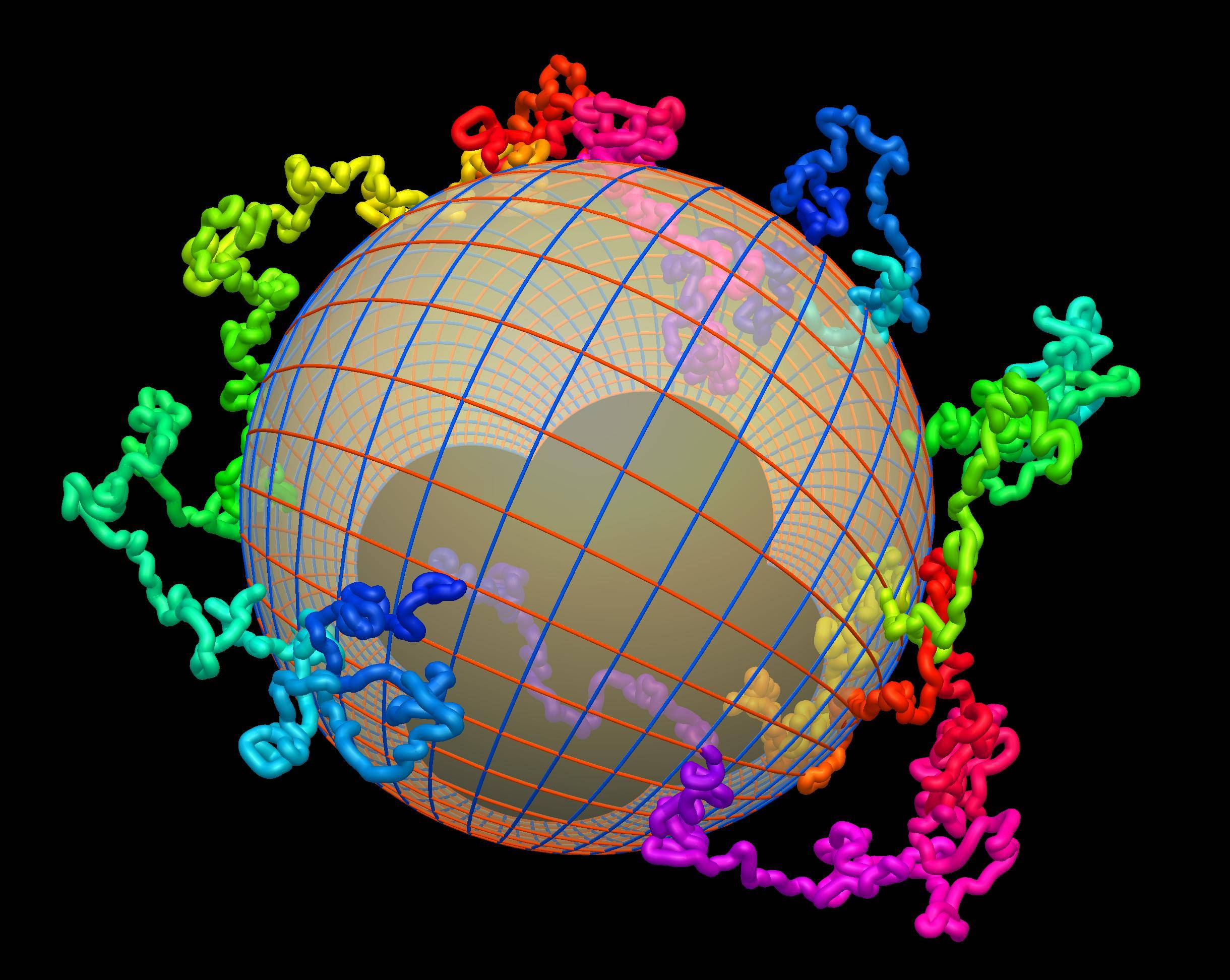The questions asked The questions asked concern one-dimensional closed-loop submanifolds of Hilbert space called Langretangles. The specific questions asked are:
- What is the large-$n$ probability $P(n)$ that an $n$-dimensional Hilbert space supports Langretangle trajectories?
- What is the large-$n$ length $L(n)$ of a generic Langretangle trajectory?
Numerical evidence suggests $P(n) \gtrsim 5/\ln(\ln n)$ and $\ln L(n)\sim \mathcal{O}(n)$.
In physical terms Langretangles are emergently-quantum trajectories on "foamy" dynamical manifolds; thus natural physics-oriented questions include "What experimental techniques are suited to the observation of Langretangle trajectories?"

Caption A typical Langretangle trajectory $\mathcal{L}(\psi_0,4,\{3,3,3\})$, drawn as a projective map $S^3\,{\to}\,R^3$. Physically this trajectory is associated to the rank-$4$ secant join of the product state of three spin-$1$ particles.
Background In a recent much-discussed preprint *Scattering Amplitudes and the Positive Grassmannian( by Nima Arkani-Hamed, Jacob L. Bourjaily, Freddy Cachazo, Alexander B. Goncharov, Alexander Postnikov, and Jaroslav Trnka (arXiv:1212.5605 [hep-th]), and in an associated lecture The Amplituhedron, coauthor Arkani-Hamed asserts the following research objective:
We can't just keep making equivalences between ideas that were essentially handed to us from the early part of the 20th century. We have to find really new things!
As a conjectural candidate for "a really new thing," Arkani-Hamed et al. describe a class of non-Hilbert dynamical systems in which unitarity and locality are encoded emergently, in geometric objects called amplituhedrons that have been depicted in the non-specialist literature as "a jewel at the heart of quantum physics"
Engineering considerations Quantum systems engineers are naturally sympathetic to the notion of dynamical systems in which unitarity and spatial locality are emergent rather than fundamental, in that large-scale quantum systems commonly are simulated by algorithms in which unitarity is only approximate (in that trajectories are integrated on non-Hilbert tensor network manifolds) and spatial locality is emergent (via Lindblad/Carmichael trajectory unravelings that dynamically quench macroscopic Schröedinger cats).
Nomenclature To concretely visualize these non-Hilbert quantum trajectories, we adopt the notation of Robert Landsberg's text Tensors: Geometry and Applications, in which the geometric objects of primary interest are secant varieties of Segre varieties
$$ L(r,\{a_i\}) \equiv \sigma_r\big(\text{Seg}(\mathbb{P}^{a_1-1}\times\cdots\times\mathbb{P}^{a_n-1})\big) \subset \mathbb{P}^{(\Pi_{i,1}^n a_i) -1} $$
Here the manifold $L(r,\{a_i\})$ is regarded as Segre-embedded in a Hilbert space of (normalized) states $\mathbb{P}^{(\Pi_{i,1}^n a_i)-1}$. Then the zabacity function $\text{zab}(r,\{a_i\})$ is defined to be the dimensional deficit
$$ \text{zab}(r,\{a_i\}) = \big((\Pi_{i,1}^n a_i)-1\big) - \dim L(r,\{a_i\}) $$
Unit-zabacity manifolds Henceforth we focus our attention upon unit-zabacity manifolds (that is, $\text{zab}(r,\{a_i\})=1$). Physically these are tensor network manifolds that almost fill the embedding Hilbert space, being dimensionally deficient by precisely one complex dimension, which is to say, by deficient by precisely two real dimensions. Among the most celebrated unit-zabacity manifolds is $L(4,\{3,3,3\})$ (see for example Theorem 5.5.2.1 of Landsberg's text) which physically is the rank-$4$ secant join of the product state of three spin-$1$ particles.
Visualizing unit-zabacity geometry The geometry of $L(4,\{3,3,3\})$, regarded as a submanifold of complex dimension 25 immersed in a normalized Hilbert space $\mathbb{P}^{3^3-1}$ of dimension $3^3-1=26$, can be concretely visualized by intersecting $L(4,\{3,3,3\})$ with any convenient three-dimensional submanifold of the immersing $\mathbb{P}^{3^3-1}$ Hilbert space; an obvious and geometrically natural candidate for such a three-dimensional submanifold is the rotation group $\text{SO}(3)\sim S^3$. Then we have:
Definition The Langretangle trajectory $\mathcal{L}(\psi_0,r,\{a_i\})$ associated to a unit-zabacity manifold $L(r,\{a_i\})$ (with $\psi_0\in L(r,\{a_i\})$) is by definition the one-dimensional submanifold of points $p\in S^3$ such that the rotated state $\psi(p)= R(p)\circ\psi_0$ satisfies $\psi(p)\in L(r,\{a_i\})$.
Numerical and graphical considerations Closed-form arbitrary-dimension representations of the quantum rotation matrix $R(p)$ (which are due to Wigner) are given in standard textbooks such as Gottfried's Quantum Mechanics (1966); quaternionic coordinates on $S^3$ are well-suited to efficient trajectory integration; graphical representations of the Hopf fibration commonly employ the simple-to-compute projective map $S^3\to R^3$; thus the exhibition of concrete Langretangle trajectories is computationally straightforward.
Langretangled trajectories For generic starting-states $\psi_0$, numerical integration of the Langretangle trajectories for $\mathcal{L}(\psi_0,4,\{3,3,3\})$ shows a striking "tangle", and higher-dimension unit-zabicity manifolds (not shown) are found to support even more tightly tangled trajectories. This tangled geometry motivates both the name of the zabacity dimension-measure (from the Persian zabd meaning "foam-like," and zubdat meaning "cream-like," as skimmed from a body of liquid) and the portmanteau word Langretangle, which derives from "Robert LANdsberg" and "Corrado SeGRE*."
Open questions The questions asked in the beginning then follow naturally from the preceding considerations (along with many more mathematical questions, needless to say). In particular, the strikingly high prevalence of unit-zabicity large-dimension Hilbert spaces apparently is associated to the numeric properties of Cunningham numbers; the question-asker would be grateful for mathematical illumination in regard to this connexion.
Physics perspectives From a physics perspective, a natural question is simply: "By what observations, either in principle or in practice, can (flat) Hilbert-space dynamical manifolds be experimentally distinguished from ("foamy") finite-zabacity dynamical manifolds, even for systems as simple (seemingly) as three interacting spin-$1$ particles?" Again, references and/or experimental suggestions are welcome.
Acknowledgements The continuing stimulus of comments by Gil Kalai in regard to issues of quantum unitarity, locality, and algebraic geometry is gratefully acknowledged.
